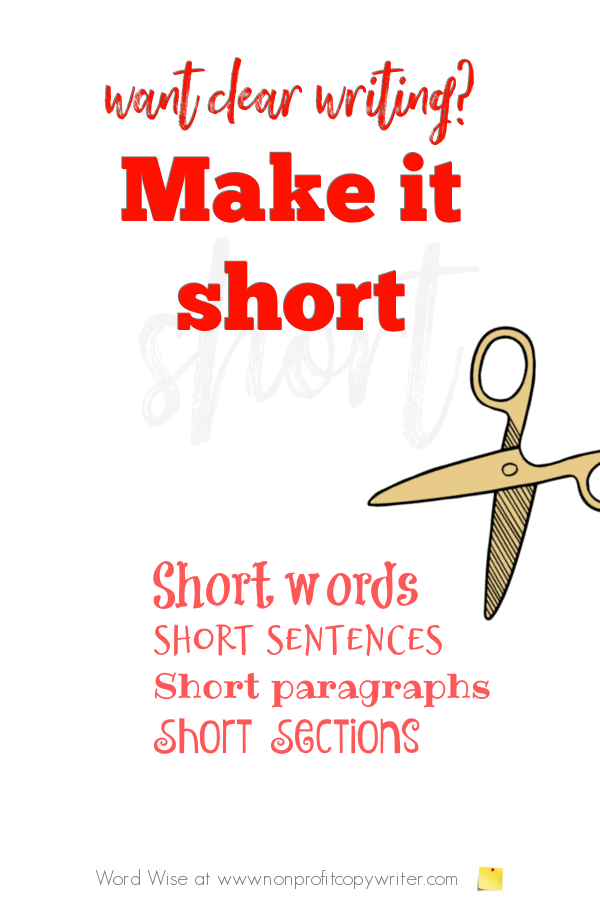Save Time: Get 5 Simple Writing Tips
you can put to use in 10 minutes
Want Clear Writing? Make It Short
Award-winning writer Kathy Widenhouse has helped hundreds of nonprofits and writers produce successful content , with 750K+ views for her writing tutorials. She is the author of 9 books. See more of Kathy’s content here.
Updated 7.11.24
Want clear writing? You’re not alone. “Very few people have the ability to write effortlessly and perfectly,” said noted technical writer Marvin H. Swift (1923–2007), writing in the Harvard Business Review. “Most of us must sweat over the process of revision, drafting, and redrafting until we get it right.”
But you can reduce your writing sweat and tears with a few simple tools. One of those tools is brevity. Clear writing is short.
What best contributes to clear writing
Bob Bly calls the approach the “4 S Formula”: short words. Short sentences. Short paragraphs. Short sections.
In truth, the 4 S’s technically aren’t a writing formula (which is a template or outline to follow as you write) but rather a helpful rule of thumb. Each of the S’s indicates a different way you can “write short.” Follow these four simple guidelines and your writing will be clearer and easier to read.
1. Short words
“I love words, but I don’t like strange ones,” said American humorist and entertainer Will Rogers (1879–1935). “You don’t understand them and they don’t understand you.” And readers don’t understand them either — or at least, are confused by them.
Much better to use a ten-cent word than a ten-dollar word so that your reader can follow your meaning. That means use rather than utilize … build rather than fabricate … end rather than terminate. If you can use a short word and keep the meaning of a phrase, do so. You’ll have clearer writing.
2. Short sentences
Research from the American Press Institute shows that readers find sentences of 8 words or less very easy to read … sentences with 11 words are easy … and sentences with 14 words fairly easy to read. A sentence containing 17 words is standard.
But get to 21 words in a sentence and readers say it’s fairly difficult to wrap their minds around your content. Bump up to 25 words and reading becomes hard and 29 words or more it’s very difficult for readers to understand and retain what you say. Want clear writing? Use short sentences.
3. Short paragraphs
Shorter paragraphs, like shorter sentences, are easier to read. In fact, short paragraphs have earned the “most-favored” status in digital content because readers skim online. But whether you’re online or on paper, you can shorten your paragraphs using these few simple tips.
- Break up long paragraphs into two or more short ones.
- Use bullet points for readability. Bullet list items have the added benefit of being short themselves.
- Vary your paragraph length. Maybe you were taught that a paragraph had to be 3–8 sentences long. Not so. A paragraph, especially online, is a single sentence or a group of sentences that communicate a complete thought.
4. Short sections
A section is a group of paragraphs that combine to make a point or address an idea. As with paragraphs, you’ve got plenty of leeway when it comes to deciding how long a section should be. And for today’s short attention spans, shorter is better.
Try these three tips for writing short sections. First, make sure you’ve got a clear topic paragraph. And second, wrap up your section with a punch … or with a sentence that leads you to the next section. Finally, help your reader visually by using subheads to show sections.
Clear writing: the short of it
“Having just the essential things is better than having way too much of superfluous things.” So says online writing instructor Jordan Conrad on the online platform Writing Explained.
Cut out the word fat from your writing and go short. Your readers will thank you. And they’ll better understand what you write.
More Editing Tips for Writers
Write Simply: Avoid 3 obstacles that keep you from being readable ...
Simplify Your Writing: Why Word Choice Matters ...
Why You MUST Master a Conversational Writing Style ...
Slay Superlatives to Show, Rather Than Tell ...
11 Weak Words to Avoid in Writing ...
Write First, Edit Later: Stop Editing While Writing With These Tips ...
19 Practical Conversational Writing Tips ...
Run-On Sentences Can Be Your Friend. Fragments, Too...
Weed out weasel words for stronger writing ...
Avoid Jargon in Your Content So Outsiders Feel Like Insiders ...
Self-Editing Tip: Start a sentence with the subject, not extra words ...
Exclamation Point?! When in Doubt, Leave It Out ...
More editing tips on our Pinterest board ...
Return from Want Clear Writing? Make It Short to Nonprofit Copywriter home
As an Amazon Associate I earn from qualifying purchases.
Share This Page

Named to 2022 Writer's Digest list
BEST GENRE/NICHE WRITING WEBSITE


Stop Wasting Time!
Grab your exclusive FREE guide, "5 Simple Writing Tips You Can Put to Use in 10 Minutes or Less"












